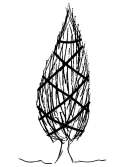 All trees can be damaged by heavy, wet snow when still in full leaf. Trees that grow quickly, such as poplars, elms and willows, with deep v-shaped crotches also tend to be more brittle and prone to breakage. Trees that have leaves or needles are more prone to collecting heavy/damaging snow loads than those that are fully dormant and bare.
All trees can be damaged by heavy, wet snow when still in full leaf. Trees that grow quickly, such as poplars, elms and willows, with deep v-shaped crotches also tend to be more brittle and prone to breakage. Trees that have leaves or needles are more prone to collecting heavy/damaging snow loads than those that are fully dormant and bare.
Conical formed trees such as conifers can generally withstand heavier snow loads, as well as deciduous with less branch area. That said, evergreens often catch larger snow loads since they never lose their full foliage. Protection of these types of trees starts with good tree selection and proper pruning.



You can also wrap the branches of upright conical evergreens to prevent the branches from splaying. If you have conical evergreen with multiple leaders (arborvitae are often multi-trunked affairs), you can gently bind the leaders together before tying up the outer branches. Be sure to untie all your supports once the threat of snowfall has passed.
Always check your young and newly planted trees during snowstorms ‑ a few gentle shakes to remove snow can go a long way to preserve drooping branches. You can use a broom to reach and shake branches higher up (note: shake, not hit. Striking branches can damage the delicate cambium layer of the bark, causing permanent damage). Do not shake too vigorously, it would be a shame to damage your trees while trying to save them. DO NOT DO THIS to large mature trees or if you have large mature trees close by. If a big branch breaks and falls, you are much harder to replace than a tree!
Originally published on April 28th, 2010. Updated on May 19th, 2022.
